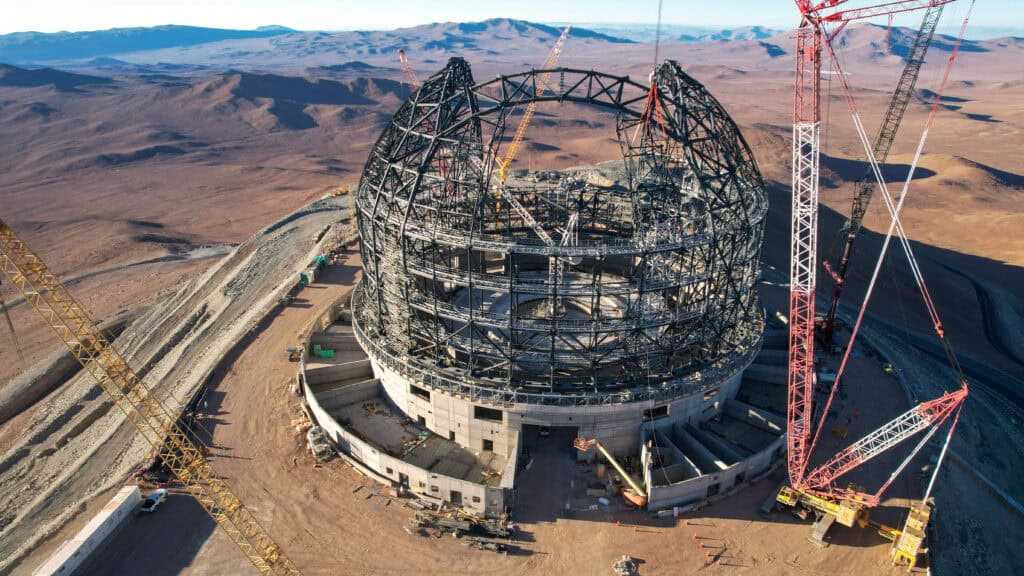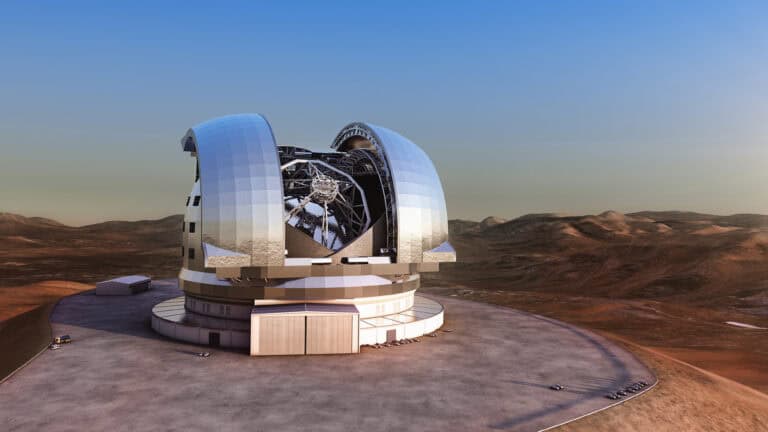(Image credit: ESO/L. Calçada)
In the desolate landscape of Chile’s Atacama Desert, a colossal structure known as the Extremely Large Telescope (ELT) is rising atop Cerro Armazones. Managed by the European Southern Observatory (ESO), this groundbreaking project aims to reshape our understanding of the universe when it becomes operational in 2028. The ELT promises images of the cosmos sharper and richer than ever before, offering astronomers new insights into the depths of space.
Engineering Marvel in the Desert
The ELT is not just a telescope but a monumental engineering feat. “We are pushing the current engineering limit,” said Davide Deiana, the deputy site manager of the ELT’s dome and main structure. “Everything has to work perfectly.” The telescope’s dome will stand 74 meters tall and 87 meters in diameter, taller than Rome’s Colosseum. The structure will house a 39-meter main mirror composed of 798 hexagonal panels, each equipped with pistons and sensors to maintain its precise shape.
Life at Paranal Observatory
Located near the existing Paranal Observatory, the ELT benefits from the region’s high altitude and extremely dry climate—ideal conditions for astronomical observations. The Paranal complex includes facilities like the Very Large Telescope (VLT) and a residence that houses up to 150 staff members. “We try to make this place feel like a home away from home,” said Vanessa Peidro, head of logistics and facilities. Staff members often spend half their time on-site, working in rotations due to the remote location.

(Image credit: ESO/L. Calçada)
Advanced Technology and Challenges
The ELT will utilize advanced adaptive optics systems, including lasers that create artificial “guide stars” in the Earth’s upper atmosphere. These guide stars help the telescope measure atmospheric turbulence and adjust its mirrors in real time, effectively canceling out distortion. “The ELT is going to be a revolution,” said Dr. Eleonora Sani, deputy head of science operations at Paranal. “Each single observation with the ELT is going to be mind blowing—something that has never been seen with such depth, with such granularity.”
Australia’s Potential Involvement
Australian astronomers have been using ESO facilities, including the VLT, since 2017 under a strategic partnership set to expire in 2027. The decision on whether Australia will join ESO as a full member is pending. Matthew Colless, an astronomer at the Australian National University, emphasized the importance of this decision: “I think that you’ll find that most Australian astronomers would say joining ESO is make-or-break for our field in this country.”
The Future of Astronomy
The ELT is expected to surpass the capabilities of current telescopes, including space-based ones like the James Webb Space Telescope. Its massive mirror and advanced technology will allow astronomers to observe the universe with unprecedented clarity. PhD student Nicholas Borsato, who recently had the opportunity to observe at Paranal, expressed his excitement: “It’s like Disneyland for astronomers. You have everything you could want here.”
Systems Engineering Perspective
From a systems engineering standpoint, the ELT represents a convergence of multiple engineering disciplines working in harmony. The project involves civil engineering, mechanical installation, control systems, optics, and environmental controls—all of which must function seamlessly. As Davide Deiana noted, “Everything has to work together like a symphony.” Constructing a 6,000-tonne rotating structure with precise alignment in a remote, seismically active desert requires meticulous planning and coordination, highlighting the intricate challenges faced by the engineering teams.
Conclusion
As construction continues, the ELT stands as a testament to human ingenuity and the relentless pursuit of knowledge. With its completion, astronomers worldwide eagerly anticipate the new horizons this powerful instrument will unveil, potentially transforming our understanding of the cosmos.
Reference
Webb, Jonathan 2024, ‘The Extremely Large Telescope is astronomy’s next big thing’, Reuters, viewed 26th November 2024, <https://www.reuters.com/technology/south-korea-team-showcases-drone-that-serves-flying-shopping-cart-2024-10-22/>

























